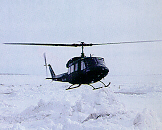HH-1H Iroquois

Mission
The HH-1H is a light-lift Air Force helicopter used for distinguished visitor transport, and support of missile sites and ranges.
Features
The pilot and co-pilot sit side-by-side and, depending on the mission, a flight engineer can be added to the crew.
Entrance to the passenger cargo area is through two sliding doors, one on each side of the aircraft. The sliding doors permit over-sized items to be loaded across the cabin. The HH-1H can accommodate up to 12 passengers, but that number and its cargo capacity is controlled by the amount of fuel necessary for the mission. For medical evacuation and ambulance service, litter racks are installed in the cab to serve six patients and one medical attendant.
Background
The HH-1H, originally designed for local air base rescue, was delivered to the Air Force in the early 1970s. It is the single-engine version of the Huey helicopters first flown in 1956, then modified into more than 15 different models over the last 30 years.
General Characteristics
Primary
Function: Support of missile sites and launch ranges.
Builder: Bell
Helicopter Co.
Power
Plant: One Lycoming T-53-L-13B turboshaft engine.
Propulsion: 1,400
shaft horsepower
Length: 57
feet, 1 inch (17.30 meters)
Width: 9
feet, 5 inches (2.87 meters)
Height: 13
feet (3.96 meters)
Maximum
Takeoff Weight: 9,500 pounds (4,275 kilograms)
Diameter
of Main Rotor: 48 feet, 4 inches (14.64 meters)
Diameter
of Tail Rotor: 8 feet, 6 inches (2.58 meters)
Range: 345-plus
miles (300-plus nautical miles)
Ceiling: 15,000
feet (4,546 meters)
Speed: 133
mph (116 knots per hour)
Load
Options: 12 passengers or six litters and one medical attendant
Crew: Two
to three; pilot and co-pilot, and depending on the mission, a flight engineer
Date
Deployed: Early 1970s
Unit
cost: $1.9 million
Inventory: Active
force, 25; ANG, 0; Reserve, 0
